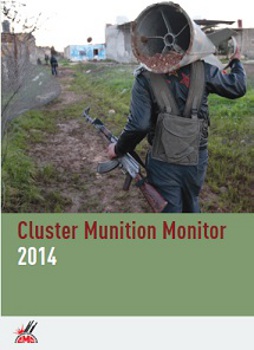27 August 2014
Strong Progress on Cluster Bomb Eradication
Shocking civilian victim rise reported in Syria as states rally to decry use of banned bombs

(Washington DC, 27 August 2014): Countries are destroying tens of millions of explosive submunitions from stockpiles and in clearance operations, while even those not yet onboard the international ban treaty have condemned the use of cluster munitions in Syria, Ukraine, and South Sudan, according to an annual global report released today by the Cluster Munition Coalition.
“This year’s use of cluster munitions shows that while these weapons have been banned by most countries of the world, some actors still flout international opinion and standards,” said Mary Wareham, Human Rights Watch, editor of the ban policy chapter of the report, entitled Cluster Munition Monitor 2014.
More than 140 countries have condemned Syria’s use of cluster munitions in statements and resolutions, including 51 states that have not joined the Convention on Cluster Munitions.
“It’s not enough to protest civilian victims of cluster munitions—all states with a conscience should join the ban convention to ensure civilians are protected from harm, now and into the future,” Wareham added.
The 2008 Convention on Cluster Munitions comprehensively prohibits cluster munitions, requires destruction of stockpiles within eight years, clearance of areas contaminated by cluster munition remnants within 10 years, and assistance for victims of the weapon.
A total of 84 states are party to the convention, while another 29 have signed, but need to ratify. No new countries have ratified or acceded to the convention yet in 2014.
Since July 2013, four countries have completed destruction of their cluster munition stockpiles: Chile, Denmark, FYR Macedonia, and the United Kingdom. During 2013, 10 States Parties including France, Germany, Italy, and Japan destroyed a total of 130,380 cluster munitions and 24 million submunitions. To date, 22 countries have destroyed 1.16 million cluster munitions and almost 140 million submunitions, representing more than three-quarters of the weapons declared stockpiled under the ban convention.
During 2013, at least of 30km2 of land was cleared of unexploded submunitions, resulting in the destruction of more than 54,000 cluster munition remnants and return of land back to communities in the six most cluster munition-contaminated states--Bosnia and Herzegovina, Cambodia, Iraq, Lao PDR, Lebanon, and Vietnam--as well as many other countries and regions.
“Appallingly, last year in Syria there were more casualties and civilian suffering from cluster munitions than at any other time or place since Monitor reporting began.” said Megan Burke, Survivor Network Project, editor of the casualties and victim assistance chapter of the report.
Data shows that there were at least 1,584 casualties from cluster munition attacks and unexploded submunitions in Syria in 2012 and 2013, while hundreds more were recorded in the first half of 2014. The vast majority of those killed—97 percent—were civilians. Already, casualties in Syria are higher than those attributed to the 2006 Israel-Lebanon conflict that triggered global outrage and contributed to the establishment of the ban convention.
In addition to Syria, where cluster munitions have been used since mid-2012, Cluster Munition Monitor 2014 recorded new use of cluster munitions in South Sudan and Ukraine in the first half of 2014, but it is not yet clear who was responsible. The use of cluster bombs in South Sudan sparked serious concern in a UN Security Council resolution in May 2014, while the use of cluster munitions in Syria was condemned by two UN General Assembly resolutions in 2013.
This year’s report is being launched by the Cluster Munition Coalition (CMC) in advance of the convention’s Fifth Meeting of States Parties, which opens in San José, Costa Rica on Tuesday, 2 September.
Useful Links
- Click here to view the Cluster Munition Monitor 2014 and related documents, including Major Findings (available in Arabic, English, French, Portuguese and Spanish)
- Click here to visit the press room, including the full press release (available in Arabic, English, French, and Spanish)


